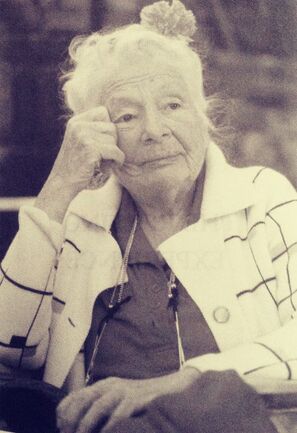Body images before & after Structural Integration sessions
|
These 2 photos show the effect of having received only 3 sessions. One can clearly see already a big improvement toward a more upright posture and allover balance. Please also read the 1. Structural integration testimonial.
|
Before and after a 10 session protocol: a taller appearance, more upright posture, and less
strain in the upper chest and neck. |
What is Structural Integration / Rolfing
In case you have never heard about this modality, here are just a few sentences to give you a general idea. I start my sessions with a brief analysis of your body posture where I will identify patterns of imbalance, tensional lines, the way your feet are positioned, tensions throughout your legs, tilts and rotations in your pelvis, the way your shoulder girdle is resting on top of the ribcage and any forward or sideward tilt of your neck and head. I also want to hear from you where you are currently experiencing discomfort or pain, your most frequent movement patterns throughout the day and all kind of accidents that have happened to you in the past.
With all this information in mind, I can device a quick plan of where to start working so that those tensional patterns can begin to unravel. And since I have been asked very often by my clients what just one session can possibly do, I can tell you that every single session brings positive change and sometimes with just a few appointments in close succession even remarkable improvements can be achieved! Of course, a more complete treatment consists of 10 sessions, a so called 10-series.
With all this information in mind, I can device a quick plan of where to start working so that those tensional patterns can begin to unravel. And since I have been asked very often by my clients what just one session can possibly do, I can tell you that every single session brings positive change and sometimes with just a few appointments in close succession even remarkable improvements can be achieved! Of course, a more complete treatment consists of 10 sessions, a so called 10-series.
What results can be expected?
As a result of receiving multiple sessions, you will feel lighter, become more flexible, and obtain a higher level of energy. Your body will be able to perform more efficiently, and your movements will be more fluid and graceful. Clients who surf report having greater endurance and fewer sore muscles the day after. People who suffered serious accidents and limitations of their range of movement have been able to regain strength, flexibility, and natural balance thoughout their body.
How does it work?
Through slow, hands-on pressure, the connective tissue system of your body is carefully manipulated to release tension in areas where the body is restricted. The tissue becomes hydrated again through this work, and thus more pliable. Each session does the groundwork for the following one, until complete integration and balance of the skeletal-fascia system is achieved. A complete treatment consists of 10 sessions and is strongly recommended in cases of long-lasting chronic pain due to severe accident or injury. There is also the possibility of receiving a shorter series of 3 or 7 sessions, and if you are curious about how this type of bodywork is different from massage, you can book just a single session and still immediately benefit.
Connective tissue system of the body is a complex 3-dimensional system of sheets, chords, and bags that wrap, divide, permeate, and connect every one of your muscles, bones, organs, nerves, and blood vessels. Fascia creates the underlying matrix of our body structure, gives us shape, and is continuous throughout the entire body. It creates a stable yet mobile, flexible, and resilient unit — our body! Without it, we would be just a big bone-filled blob.
For centuries, fascia was not even mentioned in anatomical textbooks because it is so expansive and intertwined that it resists the medical standard of being cut up and named. This lack of awareness about fascia is changing rapidly, thanks to modern research. Dr. Ida Rolf, the founder of this method, said about the goal of this work: “If you can imagine how it feels to have a fluid, light and balanced body, free of chronic pain, stiffness and stress, at ease with itself and the Earth’s gravitational field, then you will understand the goals of Structural Integration.”
Through slow, hands-on pressure, the connective tissue system of your body is carefully manipulated to release tension in areas where the body is restricted. The tissue becomes hydrated again through this work, and thus more pliable. Each session does the groundwork for the following one, until complete integration and balance of the skeletal-fascia system is achieved. A complete treatment consists of 10 sessions and is strongly recommended in cases of long-lasting chronic pain due to severe accident or injury. There is also the possibility of receiving a shorter series of 3 or 7 sessions, and if you are curious about how this type of bodywork is different from massage, you can book just a single session and still immediately benefit.
Connective tissue system of the body is a complex 3-dimensional system of sheets, chords, and bags that wrap, divide, permeate, and connect every one of your muscles, bones, organs, nerves, and blood vessels. Fascia creates the underlying matrix of our body structure, gives us shape, and is continuous throughout the entire body. It creates a stable yet mobile, flexible, and resilient unit — our body! Without it, we would be just a big bone-filled blob.
For centuries, fascia was not even mentioned in anatomical textbooks because it is so expansive and intertwined that it resists the medical standard of being cut up and named. This lack of awareness about fascia is changing rapidly, thanks to modern research. Dr. Ida Rolf, the founder of this method, said about the goal of this work: “If you can imagine how it feels to have a fluid, light and balanced body, free of chronic pain, stiffness and stress, at ease with itself and the Earth’s gravitational field, then you will understand the goals of Structural Integration.”
The pionier woman who developed this method: Dr. Ida Paulina Rolf
|
Ida P. Rolf, a native New Yorker, graduated from Barnard College in 1916; and in 1920 she earned a Ph.D. in biological chemistry from the College of Physicians and Surgeons of Columbia University. For the next twelve years Ida Rolf worked at the Rockefeller Institute where she eventually rose to the rank of Associate, no small achievement for a young woman in those days. In 1927, she took a leave of absence from her work to study mathematics and atomic physics at the Swiss Technical University in Zurich. During this time, she also studied homeopathic medicine in Geneva.
Returning from Europe, she spent the decade of the 1930’s seeking answers to personal and family health problems. Medical treatment available at that time seemed inadequate to her; this led to her exploration of osteopathy, chiropractic medicine, yoga, the Alexander technique and Korzybski’s work on states of consciousness. By the 1940’s, she was working in a Manhattan apartment where her schedule was filled with people seeking help. She was committed to the scientific point of view, and yet many breakthroughs came intuitively through the work she did with chronically disabled persons unable to find help elsewhere. This was the work eventually to be known as Structural Integration. For the next thirty years, Ida Rolf devoted herself to developing her technique and training programs. |
During the 1950’s, her reputation spread to England where she spent summers as a guest of John Bennett, a prominent mystic and student of Gurdjieff. Then, in the mid-60’s, Dr. Rolf was invited to Esalen Institute in California at the suggestion of Fritz Perls, founder of Gestalt Therapy. There she began training practitioners and instructors of Structural Integration.
The more Structural Integration classes Ida Rolf taught, the more students sought admission to training. Newspaper and magazine articles began featuring the person and work of Ida Rolf, and soon the necessity for a formal organization became apparent. As early as 1967, the first Guild for Structural Integration was loosely formed and eventually headquartered in a private home in Boulder, Colorado.
Until her death in 1979, Ida Rolf actively advanced training classes, giving direction to her organization, planning research projects, writing, publishing and public speaking. In 1977, she wrote Rolfing: The Integration of Human Structures (Harper and Row, Publishers). This book is the major written statement of Ida P. Rolf’s scholastic and experiential investigation into the direct intervention with the evolution of the human species. Another book compiled by Dr. Rolf’s close associate and companion: Rosemary Feitis, is Ida Rolf Talks About Rolfing and Physical Reality. It is truly a jewel: giving us insights into Dr. Rolf’s unique and incredible mind.
The more Structural Integration classes Ida Rolf taught, the more students sought admission to training. Newspaper and magazine articles began featuring the person and work of Ida Rolf, and soon the necessity for a formal organization became apparent. As early as 1967, the first Guild for Structural Integration was loosely formed and eventually headquartered in a private home in Boulder, Colorado.
Until her death in 1979, Ida Rolf actively advanced training classes, giving direction to her organization, planning research projects, writing, publishing and public speaking. In 1977, she wrote Rolfing: The Integration of Human Structures (Harper and Row, Publishers). This book is the major written statement of Ida P. Rolf’s scholastic and experiential investigation into the direct intervention with the evolution of the human species. Another book compiled by Dr. Rolf’s close associate and companion: Rosemary Feitis, is Ida Rolf Talks About Rolfing and Physical Reality. It is truly a jewel: giving us insights into Dr. Rolf’s unique and incredible mind.
Privacy Policy
© 2016 Copyright Sayulita Holistic Bodywork
© 2016 Copyright Sayulita Holistic Bodywork









